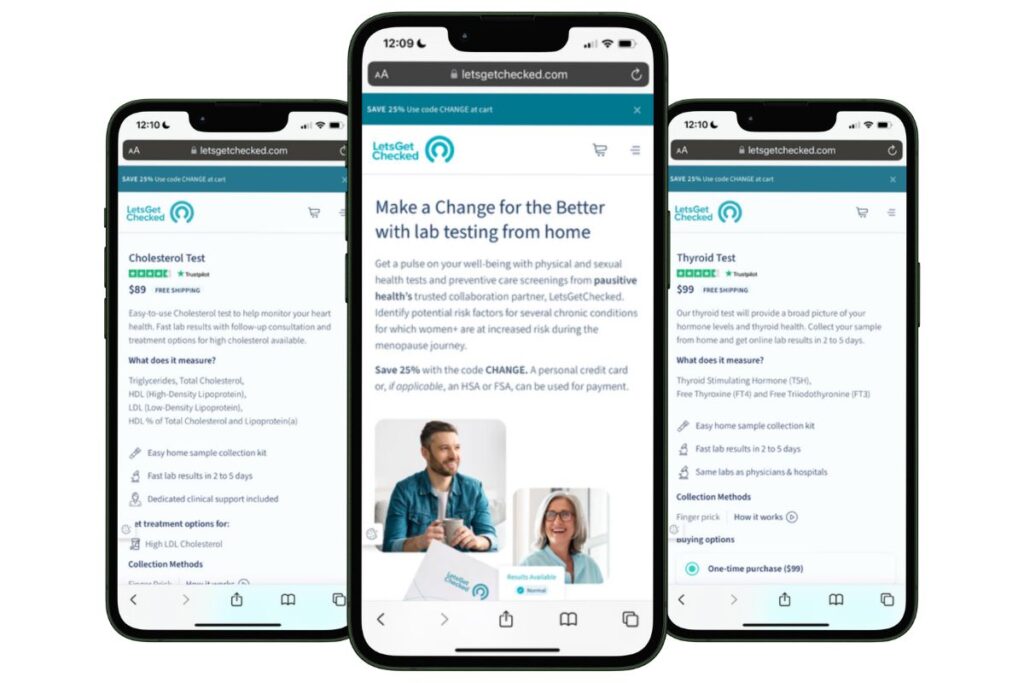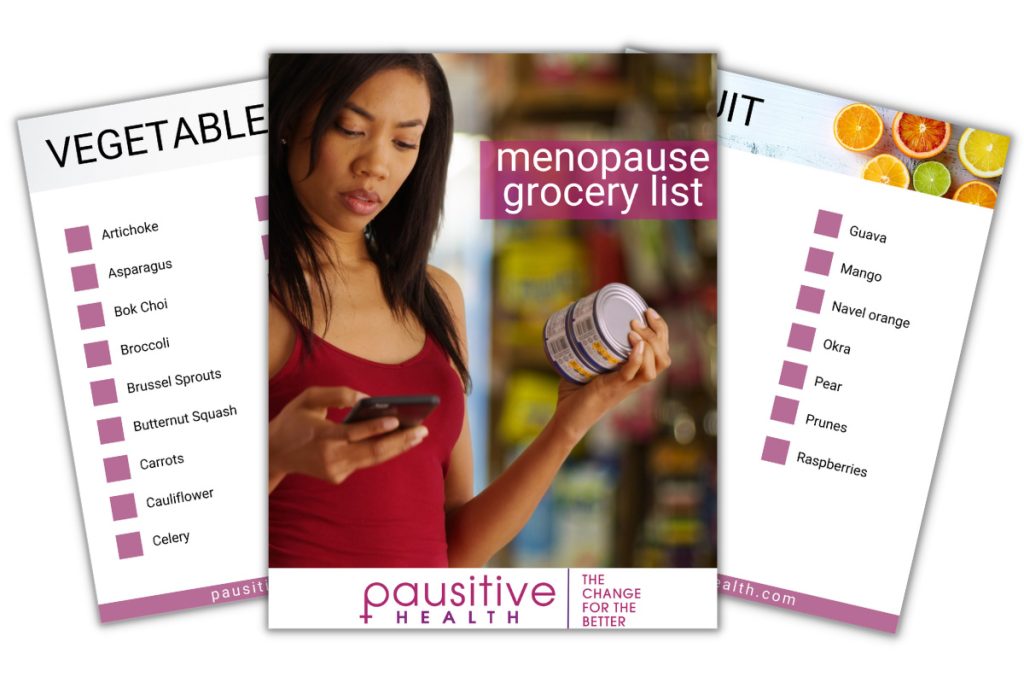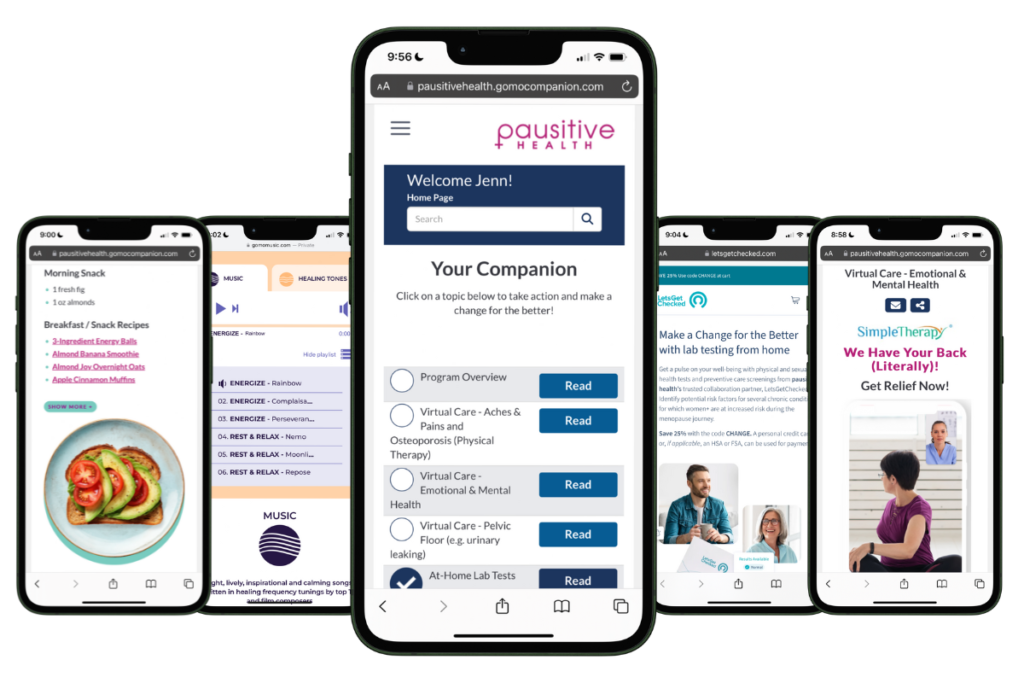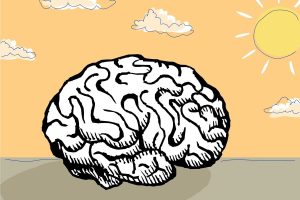The menopause journey can be an empowering time, a chance to embrace self-reflection and heart-healthy lifestyle habits to help you manage symptoms. That action can also help mitigate the increased risk of cardiovascular disease during menopause. Heart disease is the #1 cause of death in women+, even more deadly than all cancers combined. Menopause impacts your heart health, but it’s never too late to change your lifestyle to improve your overall well-being and heart health.
The link between menopause and heart health
45-64-year-old women+ have the fastest-growing cardiovascular disease (CVD) rates. Do you fall in that age range?
Not surprisingly, this timeframe aligns with the stages of menopause, which can increase the risk of cardiovascular disease.
Why does the risk go up?
During the pre-menopausal years, estrogen is protective of the heart. Namely, it relaxes the arteries and promotes good cholesterol.
Its heart-healthy function likely explains why men, who have less estrogen, are more likely to develop heart disease several years earlier than women.
As menopause approaches, estrogen declines, and the risk of both fatty plaque buildup and the narrowing of coronary arteries increases. Accordingly, this is when doctors start to see more cardiovascular disease.
What is cardiovascular disease?
You’ve likely heard the term cardiovascular disease, but did you know it’s more than just heart health?
Cardiovascular disease includes:
- heart disease
- hypertension
- stroke
Estrogen and stroke risks
After heart disease, stroke is the second leading cause of death globally. And it’s a type of cardiovascular disease.
A stroke damages the brain. It occurs when not enough oxygenated blood reaches the brain (e.g., narrowed blood vessel or blood clot) or a blood vessel bursts in the brain, leading to a brain bleed. Globally, it’s the second leading cause of death in the world.
Estrogen has also shown the potential to reduce stroke risk. Understand your risk factors based on your GYN history and exposure to estrogen through the years.
Studies show the longer you’ve been exposed to estrogen (over a lifetime), the lower the risk of ischemic (insufficient oxygen) strokes and intracerebral hemorrhages (bleeds).
This exposure level is measured based on the accumulation of factors such as:
- reproductive lifespan (time between your first period and menopause)
- oral contraceptives
- hormone therapy
- number of births
- duration of breastfeeding
By the time you reach menopause, you can’t do much to leverage this positive impact of estrogen exposure other than considering hormone therapy. But that comes with its own set of potential risks.
So, what can you do to minimize the risk? Be heart-healthy!
Heart healthy steps you can take
Given every woman+ will eventually experience the menopause journey and many will have symptoms, it’s important to understand the risks of developing CVD so you can turn them into heart-healthy steps.
CVD risk factors include:
- diabetes
- smoking and secondhand smoke exposure
- sedentary lifestyle
- unhealthy eating – diet high in saturated fats, trans fat, and cholesterol
- family history
- alcohol
- race/ethnicity
- where you live
- LGBTQIA+
- disability status
- gynecological history
- menopause symptoms
- metabolic syndrome
Even if you have never been diagnosed with CVD, maintaining a healthy lifestyle is important for preventing a first CVD event.
One study showed a 20-year lower risk for a CVD event in postmenopausal women+ with a normal BMI who scored higher on a healthy lifestyle index.
But caring for your cardiovascular health doesn’t have to be complicated, even though it might not always be easy. Below, find research-backed ways to maintain optimal CVD health.
The menopausal stage of life is a great opportunity to promote both heart and total body health and well-being. Jump to the section you’d like to learn more about, so you can take heart healthy steps today.
Heart Healthy Steps
1. Get regular health screenings.
When life gets busy, you may catch yourself skipping visits to your healthcare practitioner. But, regular health screenings are essential for staying on track and catching risk factors early.
For heart health specifically, the American Heart Association recommends these checks:
- cholesterol– every five years
- blood pressure– at least every two years
- blood glucose levels – every three years
- waist circumference – as needed
- body mass index– every regular healthcare visit.
(If you already have high blood pressure, diabetes, or elevated cholesterol or are overweight or obese, you can expect the frequency to increase as advised by your doctor.)
More regular screenings can be beneficial, especially if you’re already at risk or have biological family members who’ve experienced heart disease.

Discounted At-Home Lab Testing
Convenient & Confidential
Preventive care is important during the menopause journey because the hormonal transition increases your risk of chronic conditions related to both your physical and mental health. Get an easy-to-use at-home lab test(s) delivered in discreet packaging, from our collaborative partner LetsGetChecked. Follow-up with a clinician for abnormal test results, and telehealth is available to assess your health and need for prescriptions and treatment.
For 25% off the tests, use code “pausitive” at checkout.
If you order at-home lab testing, we may receive a small commission.
Understand risk factors
In conjunction with visits to your doctor, understand your risk factors during menopause.
You can also use calculators such as this one to estimate your cardiovascular risk.

2. Try wearable devices
Wearable devices can be another great tool to assess your heart health even more regularly. Many devices come in discreet or stylish forms, such as wristbands or rings with sensors to track metrics, including step count, exercise, heart rate, and sleep.
Some devices detect heart arrhythmia, ECGs (electrocardiograms), and oxygen levels for heart health.
Despite their benefits, surveys show fewer Americans with heart disease or metabolic syndrome use a wearable device. But, seeing your health markers in real-time can help motivate you to make better daily choices.
Discussing the potential benefit with your doctor can help determine if/which might make sense for your situation. Depending on the device, there is a wide range of cost, quality, and accuracy. You will also want to consider any data privacy concerns and how your information will be used (or sold) by the company collecting it.
3. Get/stay physically active
One of the most potent ways to benefit your heart health is exercise. Increasing physical activity reduces the risk of heart disease, stroke, high blood pressure, and cancer. It also improves bone health, weight control, sleep, and mental health.
Exercise even aids in preventing and managing Type 2 diabetes by making our bodies more sensitive to insulin, the hormone that enables cells to use blood sugar for energy.
Despite these benefits, if exercise is not a regular part of your routine, it can be hard to know where to start.
Luckily, the federal guidelines are simple:
- aim for at least 150 minutes per week of moderate-intensity aerobic exercise (e.g., a brisk walk, leisurely bike ride, or easy jog) or 75 minutes per week of vigorous aerobic exercise (e.g., HIIT – High-Intensity Interval Training, running, or swimming laps).
- Adding strength training and activities that help with flexibility and balance are also important to your overall health and well-being.
How to get motivated to exercise during menopause
If you find yourself dreading workouts, reframe them as sources of power, strength, and the ability to do things you enjoy rather than punishments or chores on your to-do list.
You don’t have to be an ultra-marathoner to stay in shape or promote good heart health. For example, research shows dancing can improve lipid profiles in menopausal women. And don’t forget to switch up your routines to avoid boredom and a plateau for your body.
NEAT exercises
Don’t discount the benefits of NEAT (non-exercise activity thermogenesis) either. Unplanned exercises like shopping, cleaning, or even fidgeting can substantially impact our metabolic expenditures. One 12-year study found that fidgeting may reduce the risk of death in women+ associated with being sedentary.
Even if you’ve struggled to maintain an active lifestyle in the past, it’s never too late to get started. That said, the earlier you start, the greater the benefits—which is the reason to start today.
Lastly, every little bit helps. Doing something is usually better than nothing and can help you live longer. A study published in the European Journal of Preventive Cardiology found 2,337 steps a day reduced the risk of dying from cardiovascular disease and walking at least 3,967 steps a day started to reduce the risk of dying from any cause.
The risk of dying (prematurely) from cardiovascular disease as well as any other cause significantly with every 500 to 1000 extra steps walked.

4. Change your mindset about healthy foods
While losing weight is often a recommendation for improving heart health, what we eat is just as important for reducing CVD risk.
A heart-healthy diet is lower in fats (not including healthy fats such as olive and fish oils) and higher in whole, plant-based foods.
As a rule of thumb, avoid highly processed foods and fill your plate with nutrient-dense vegetables and lean, high-quality proteins such as grass-fed beef and fish.
Rather than creating a restrictive mindset around your diet (“I can’t eat this donut!”), focus on first adding nourishing foods you love.
For example, trying a recipe with aromatic herbs, treating yourself to a fancy salad shop for lunch, and enjoying fresh fruit after dinner are just some of the many ways to make healthy eating easier. If you’re unsure where to start, these delicious foods are especially beneficial for heart health:
Healthy foods
Fatty Fish
Fatty fish like salmon, mackerel, trout, and sardines are rich in omega-3 fatty acids. These healthy fats can help reduce inflammation, lower triglycerides, and slow plaque buildup in the arteries, thus reducing the risk of heart disease.
Oats and Whole Grains
Whole grains such as oats, quinoa, and brown rice are high in soluble fiber, which helps lower cholesterol levels.
Berries
Berries like blueberries, strawberries, and raspberries are packed with antioxidants, fiber, and vitamins. These nutrients help reduce blood pressure and improve overall heart health. Add them to your breakfast smoothies, or enjoy them as a healthy snack.
Nuts and Seeds
Almonds, walnuts, chia seeds, and flaxseeds are excellent sources of healthy fats, including omega-3s and fiber. They can help lower bad cholesterol levels and reduce inflammation.
Leafy Greens
Leafy greens like spinach, kale, and collard greens are rich in vitamins, especially vitamin K, which helps protect arteries and promotes healthy blood clotting.
Legumes
Beans, lentils, and chickpeas are high in fiber, which can help lower cholesterol and improve heart health. They’re also excellent sources of plant-based protein.
Avocado
Avocado is a unique fruit packed with monounsaturated fats, which are heart-healthy fats that can help reduce bad cholesterol levels. In fact, eating two servings of avocado per week has been shown to reduce the risk of heart disease.
Tomatoes
Tomatoes are rich in lycopene, an antioxidant that’s linked to reduced risk of heart disease. Cooked tomatoes release even more lycopene (e.g., tomato sauce or tomato soup).
Olive Oil
Extra-virgin olive oil is a staple of the Mediterranean diet and is associated with a lower risk of heart disease. It’s rich in monounsaturated fats and antioxidants, which help reduce inflammation and improve cholesterol levels. Note that because it’s high in fat (and therefore calories), use it sparingly—a drizzle for cooking or salads goes a long way.
Dark Chocolate
Yes, you read that right! Dark chocolate (in moderation) can be a heart-healthy treat to add to your diet. It contains antioxidants called flavonoids, which can help improve heart health. Choose dark chocolate with at least 70% cocoa content for maximum benefits without excess added sugar.
Garlic
Easy to incorporate into a variety of dishes for added flavor, garlic is known for its potential to reduce blood pressure and improve cholesterol levels.
As you enjoy more heart-protective foods, don’t forget portion control. Overeating, even healthy foods, can lead to weight gain, which increases the risk of overweight/obesity and, therefore, heart disease. Pay attention to portion sizes and try to eat mindfully, savoring each bite.

Make A Change For The Better!
This menopause grocery list contains a combination of foods specifically selected to help you feel better today and even better in the future.
"*" indicates required fields
Avoid these in your diet
Understanding the specific drawbacks of these foods can also help you make more informed choices:
Saturated and Trans Fats
Saturated and trans fats are known to raise LDL (low-density lipoprotein) cholesterol levels, commonly called “bad” cholesterol. High levels can be found in red meat, full-fat dairy products, and certain processed foods.
Added Sugars
Excessive sugar intake can contribute to weight gain and obesity, which are risk factors for heart disease. As a guideline for your intake, the American Heart Association suggests that women+ consume a maximum of 100 calories (about 6 teaspoons or 24 grams) per day.
Excess Salt
High sodium intake is linked to hypertension, which can increase strain on your heart. Reduce your salt intake by choosing fresh, whole foods over processed and fast food restaurant meals.
Processed Foods
Processed and fast foods often contain unhealthy fats, excess salt, and added sugars. One study found that each daily serving of processed food was linked to a 7% increase in the risk of CVD.
5. Address stress and depression.
The mind-body connection is powerful, and this truth holds for heart health. Depression is linked to almost a doubled risk of stroke in middle-aged women, according to research from the American Heart Association. And, during menopause, the risk of depression goes up.
Stress can also raise blood pressure, contributing to metabolic syndrome over time.
Even when life gets hectic, caring for our mental health is attainable. Just as we care for our bodies through physical activity and eating well, caring for our mind and emotions requires simple, intentional effort.
Here are some great ways to reduce and relieve stress:
Try mindful meditation
Mindfulness meditation is a powerful technique for stress reduction. By focusing on the present moment, mindfulness helps you let go of anxiety and worries about the future. Regular practice can lower blood pressure, reduce the risk of heart disease, and improve overall mental well-being. Even just a few minutes of daily meditation can make a significant difference.
Get/Stay connected
Strong social connections are invaluable in reducing stress. Spending time with friends and family, sharing your feelings, and seeking emotional support can help alleviate stress and improve your heart health. Surrounding yourself with a supportive network can make a world of difference in coping with life’s challenges.
Get organized
Balancing work, family, and personal life can be challenging, but effective time management can significantly reduce stress. Test different systems, from monthly planners to time management apps, to help you prioritize tasks, set achievable goals, and avoid overcommitting. Plus, when you manage your time effectively, you’ll find more opportunities for relaxation.
Limit caffeine
- Avoiding an excessive intake of stimulants like caffeinated coffee and tea is crucial for heart health and stress management. These substances can raise heart rate and contribute to anxiety.

Find a creative outlet.
Creativity can take many forms, from painting to poetry to re-decorating your bedroom. In addition to bringing beauty into your life, it can help you focus on the present moment, which has been shown to reduce cortisol levels and promote relaxation. Expressing your emotions can also help you communicate and process how you feel.
Seek professional help.
Sometimes, stress can become overwhelming and persistent, leading to conditions like chronic anxiety or depression. In such cases, it’s essential to seek help from a mental health professional who can provide guidance, therapy, or medication if necessary.
6. Rethink alcohol consumption.
Recent studies indicate that potentially any consumption of alcohol increases the risk of cardiovascular disease, with the risk increasing as the amount of alcohol intake rises.
Alcohol also increases the risk of osteoporosis, dementia, and cancer – including breast. And for some women+, alcohol triggers hot flashes and/or increases their severity, disrupts sleep, and can contribute to weight gain.
If you do decide to drink alcohol, try to avoid more than one drink a day:
- 12 ounces of beer
- 4 ounces of wine
- 5 ounces of 80-proof spirits
7. Stop smoking
Smoking is a major cause of cardiovascular disease. Active smoking and second-hand smoke exposure cause 32% of coronary heart disease deaths.
Chemicals in cigarette smoke cause the cells that line blood vessels to become swollen and inflamed, which can narrow the blood vessels and lead to many cardiovascular conditions.
Smoking also raises triglyceride levels and lowers HDL cholesterol levels. And nicotine makes tobacco use addictive.
That said, people successfully quit smoking every day! Once you stop, you reduce the risk of cardiovascular disease relatively quickly.
Even long-time smokers can see rapid health improvements when they quit. Within a year, heart attack risk drops dramatically. Within five years, most smokers cut their risk of stroke to nearly that of a nonsmoker. Even a few cigarettes now and then damage the heart, so the only proven strategy to keep your heart safe from the effects of smoking is to quit.
Source: Centers for Disease Control and Prevention
For support, explore resources such as the American Lung Association’s Freedom from Smoking program.

8. Improve your sleep habits
A great night’s rest should not be a luxury. But, during menopause, many women experience disruptions from symptoms such as night sweats.
For heart health, getting sufficient sleep is essential. Sleep deprivation can lead to elevated blood pressure, which is a major risk factor for cardiovascular problems. Additionally, poor sleep quality with irregular sleep patterns and number of hours can contribute to inflammation and the , both increasing the risk of heart disease.
Quality sleep also helps regulate the body’s stress response, which, when dysregulated, can lead to hypertension. Additionally, reduced sleep has been associated with of LDL cholesterol.
But even if you’ve been tossing and turning, better sleep can be within reach using these tips:
Stick to a consistent schedule.
Our bodies thrive on routine. Going to bed and waking up at the same time every day helps regulate your body’s internal clock, making it easier to fall asleep and wake up feeling refreshed.
Create a relaxing bedtime ritual.
Develop a soothing pre-sleep routine to signal to your body that it’s time to wind down. Activities like reading a book, taking a warm bath, or practicing relaxation exercises can prepare your mind for rest.
Limit screen time before bed.
The blue light emitted by smartphones, tablets, and computers can disrupt your sleep-wake cycle. Avoid screens for at least an hour before bedtime, or use blue light filters if you must use your devices.
Optimize your sleep environment.
Your bedroom should be a comfortable and calming space. Ensure your mattress and pillows provide adequate support and keep the room cool, dark, and quiet. Consider blackout curtains and earplugs if necessary.
Mind your food, caffeine, and alcohol intake.
Avoid heavy meals, caffeine, and alcohol close to bedtime. These substances can interfere with your sleep quality. Opt for a light, balanced snack if you’re hungry before bed.
Stay active during the day.
Regular physical activity can promote deeper and more restful sleep. However, avoid vigorous exercise close to bedtime, as it can have the opposite effect.
Limit naps
While short power naps can be refreshing, long or late-afternoon naps can interfere with your nighttime sleep. If you must nap, keep it brief (20-30 minutes).
Get exposure to natural light.
Exposure to natural light during the day helps regulate your body’s circadian rhythm. Spend time outdoors or open your curtains during the morning to signal to your body that it’s time to be alert.

Don’t wait to get started
No matter where you are on your menopause journey, you can start improving your habits and reducing your risk of cardiovascular disease as soon as today. As you experience the benefits of making a change for the better, you’ll likely be more and more motivated to keep going.

Free Support
For Your Menopause Journey!
Only available for a limited time!
Access a one-stop menopause journey digital destination that provides personalized text messages that focus on educational topics you select and offers many other features such as a diet assessment with recommendations, solutions from collaboration partners to address menopausal aches and pains (the musculoskeletal syndrome of menopause – MSM), pelvic floor issues, virtual care, lifestyle tools, and a supportive community.
The connection between menopause and cardiovascular disease risks | American Heart Association
How Is Heart Disease Different in Women? | Yale Medicine
Heart palpitations and high blood pressure during menopause | Nature’s Best
Longer Estrogen Exposure Could Reduce Stroke Risk after Menopause | Genetic Engineering & Biotechnology News
Healthy lifestyle important to primary prevention in postmenopausal women with normal BMI | Healio
In older patients with hardened arteries, women at greater risk for CV events vs. men | Healio
Heart-Health Screenings | American Heart Association
How To Get Your Cholesterol Tested | American Heart Association
Understanding Blood Pressure Readings | American Heart Association
Heart Health Tests for People with Diabetes | American Heart Association
Body Mass Index (BMI) in Adults | American Heart Association
ASCVD Risk Estimator | American College of Cardiology and American Heart Association
Americans with Heart Disease Less Likely to Use Wearable Devices | MedpageToday
About Insulin Resistance and Type 2 Diabetes | Centers for Disease Control and Prevention
Teixeira, Giovana Rampazzo PhD; Veras, Allice Santos Cruz MD; Rocha, Ana Paula Rodrigues MD; Chedid, Sylvia Seidinger MD; Freitas Júnior, Ismael Forte PhD; Neto, Raul Antônio Fragoso PhD; Gobbo, Luis Alberto PhD; Buonani, Camila PhD. Dance practice modifies functional fitness, lipid profile, and self-image in postmenopausal women. Menopause 28(10):p 1117-1124, October 2021. | DOI: 10.1097/GME.0000000000001818
Banach M, Lewek J, Surma S. Penson P, Stanisław S, Sahebkar A, Martin S, Bajraktari G, Henein M, Reiner Z, Bielecka-Dąbrowa A, Bytyçi I, Group L. (ILEP). The Association Between Daily Step Count and All-Cause and Cardiovascular Mortality: A Meta-Analysis Running title: Daily steps and mortality: A dose-response meta-analysis. European Journal of Preventive Cardiology.
DO – 10.1093/eurjpc/zwad229
Health Impact of Fidgeting | MJH Life Sciences
Women’s unique risk factors | Heart and Stroke Foundation of Canada
Fish and Omega-3 Fatty Acids | American Heart Association
Whole Grains, Refined Grains, and Dietary Fiber | American Heart Association
Berry Good for your Heart | Johns Hopkins Health
Nuts and your heart: Eating nuts for heart health | Mayo Clinic
Blekkenhorst LC, Sim M, Bondonno CP, Bondonno NP, Ward NC, Prince RL, Devine A, Lewis JR, Hodgson JM. Cardiovascular Health Benefits of Specific Vegetable Types: A Narrative Review. Nutrients. 2018 May 11;10(5):595. doi: 10.3390/nu10050595. PMID: 29751617; PMCID: PMC5986475.
Love those legumes! | Harvard Health Publishing
Eating two servings of avocados a week linked to lower risk of cardiovascular disease | American Heart Association
Behold, the power of tomatoes! | Humana
3 Vegetables That Are Healthier When Cooked | Denver Health Medical Plan
The benefits of adding a drizzle of olive oil to your diet | American Heart Association
Choose dark chocolate for your heart | Mayo Clinic Health System
Three reasons a heart loves garlic | Providence Health & Services
Fats, oils and heart health | National Heart Foundation of Australia
The sweet danger of sugar | Harvard Health Publishing
Get the Scoop on Sodium and Salt | American Heart Association
Ultra-Processed Foods Are Breaking Your Heart | American College of Cardiology
How to Prevent Heart Disease After Menopause | American Heart Association
Your Heart and Diabetes | Centers for Disease Control and Prevention
Fight Stress With The Power of Connection | American Heart Association
Martino J, Pegg J, Frates EP. The Connection Prescription: Using the Power of Social Interactions and the Deep Desire for Connectedness to Empower Health and Wellness. Am J Lifestyle Med. 2015 Oct 7;11(6):466-475. doi: 10.1177/1559827615608788. PMID: 30202372; PMCID: PMC6125010.
Spilling the Beans: How Much Caffeine is Too Much? | U.S. Food & Drug Administration
Does Caffeine Cause Anxiety? | Healthline
Kaimal G, Ray K, Muniz J. Reduction of Cortisol Levels and Participants’ Responses Following Art Making. Art Ther (Alex). 2016 Apr 2;33(2):74-80. doi: 10.1080/07421656.2016.1166832. Epub 2016 May 23. PMID: 27695158; PMCID: PMC5004743.
Hu J, Zhang J, Hu L, Yu H, Xu J. Art Therapy: A Complementary Treatment for Mental Disorders. Front Psychol. 2021 Aug 12;12:686005. doi: 10.3389/fpsyg.2021.686005. PMID: 34456801; PMCID: PMC8397377.
Biddinger KJ, Emdin CA, Haas ME, et al. Association of Habitual Alcohol Intake With Risk of Cardiovascular Disease. JAMA Netw Open. 2022;5(3):e223849. doi:10.1001/jamanetworkopen.2022.3849
Your Guide to the 50th Anniversary Surgeon General’s Report on Smoking and Health | Centers for Disease Control and Prevention
Gallucci G, Tartarone A, Lerose R, Lalinga AV, Capobianco AM. Cardiovascular risk of smoking and benefits of smoking cessation. J Thorac Dis. 2020 Jul;12(7):3866-3876. doi: 10.21037/jtd.2020.02.47. PMID: 32802468; PMCID: PMC7399440.
Freedom From Smoking® | American Lung Association
Sleep deprivation: A cause of high blood pressure? | Mayo Clinic
Sleep tips: 6 steps to better sleep | Mayo Clinic
Why You Should Ditch Your Phone Before Bed | Cleveland Clinic
Tips for Better Sleep | Centers for Disease Control and Prevention
Better Sleep: 3 Simple Diet Tweaks | Johns Hopkins Medicine
Does Napping During the Day Affect Your Sleep at Night? | Sleep Foundation
Effects of Light on Circadian Rhythms | Centers for Disease Control and Prevention
You may also like…

18 Cardiovascular Risk Factors Menopausal Women Need To Know
Cardiovascular disease (CVD) is the #1 killer in women. Learn 18 cardiovascular risk factors menopausal women need to know.

Conquer Menopausal Hot Flashes And Sleeplessness With CBT
Learn about cognitive behavioral therapy or CBT to help manage hot flashes, night sweats, and sleeplessness.

Foods For Menopause: 9 Best Foods To Help Menopause
Did you know you can manage your menopause symptoms with food? Learn the 10 best foods packed with the necessary nutrients to feel better.

